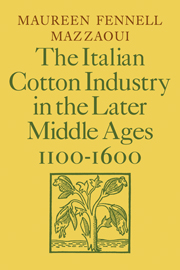Book contents
- Frontmatter
- Contents
- List of illustrations
- Preface
- List of abbreviations
- Map
- Introduction
- PART ONE THE ROLE OF COTTON IN THE MEDITERRANEAN ECONOMY
- PART TWO THE ORGANIZATION OF THE NORTH-ITALIAN INDUSTRY
- PART THREE THE GROWTH OF COTTON MANUFACTURE NORTH OF THE ALPS
- 7 Italy and south Germany 1300–1600
- 8 European cotton manufacture on the eve of the Industrial Revolution
- APPENDICES
- Notes
- Select bibliography
- Index
7 - Italy and south Germany 1300–1600
Published online by Cambridge University Press: 05 March 2012
- Frontmatter
- Contents
- List of illustrations
- Preface
- List of abbreviations
- Map
- Introduction
- PART ONE THE ROLE OF COTTON IN THE MEDITERRANEAN ECONOMY
- PART TWO THE ORGANIZATION OF THE NORTH-ITALIAN INDUSTRY
- PART THREE THE GROWTH OF COTTON MANUFACTURE NORTH OF THE ALPS
- 7 Italy and south Germany 1300–1600
- 8 European cotton manufacture on the eve of the Industrial Revolution
- APPENDICES
- Notes
- Select bibliography
- Index
Summary
The twelfth and thirteenth centuries witnessed the rapid development of cotton manufacture in northern Italy based on a high level of technological innovation and the creation of new commercial outlets in European markets. In the early fourteenth century this trend was reversed. The rate of growth slackened and in some areas halted. The level of production and exports fell off, thus initiating a long and gradual decline which extended across the following two centuries. The setbacks which occurred in this industrial sector were both coincident with and intimately related to a general economic crisis in the European economy in the fourteenth and the early fifteenth centuries. The causes, geographical extent and duration of the crisis are still the subject of intense debate. So too is the degree of economic slump and the rate of recovery, the assessment of which is hampered by the lack of reliable statistical indicators either for single regions or for Europe as a whole. Perhaps the most salient feature of this period is the dramatic contraction caused by the Black Death. However, the effects of the plague must be carefully distinguished from the longterm trends which manifested themselves in the late thirteenth century and were in turn an outgrowth of basic imbalances in economic development in the preceding age of prosperity.
By the late thirteenth century, the basic thrust toward agricultural expansion which had begun around 1050 was largely spent, although it continued in certain regions such as the eastern Baltic for some decades beyond this period.
- Type
- Chapter
- Information
- The Italian Cotton Industry in the Later Middle Ages, 1100–1600 , pp. 129 - 153Publisher: Cambridge University PressPrint publication year: 1981



